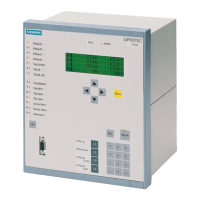Ι
max
= k · Ι
Nom Obj.
In addition to the k factor (parameter 49 K-FACTOR) the TIME CONSTANT τ
th
and the alarm temperature 49
Θ ALARM (in percent of the trip temperature Θ
TRIP
) must be specified.
Overload protection also features a current warning element (I ALARM) in addition to the temperature
warning element. The current warning element may report an overload current prematurely, even if the calcu-
lated operating temperature has not yet attained the warning or tripping levels.
Coolant Temperature (Ambient Temperature)
The device can account for external temperatures. Depending on the type of application, this may be a coolant
or ambient temperature. The temperature can be measured via a temperature detection unit (RTD-box). For
this purpose, the required temperature detector is connected to detector input 1 of the first RTD-box (corre-
sponds to RTD 1). If incorrect temperature values are measured or there are disturbances between the RTDbox
and the device, an alarm will be issued and the standard temperature of Θ
u
= 40 °C is used for calculation with
the ambient temperature detection simply being ignored.
When detecting the coolant temperature, the maximum permissible current Ι
max
is influenced by the tempera-
ture difference of the coolant (in comparison with the standard value = 104° F or 40° C). If the ambient or
coolant temperature is low, the protected object can support a higher current than it does when the tempera-
ture is high.
Extension of Time Constants
When using the device to protect motors, the varying thermal response at standstill or during rotation may be
correctly evaluated. When running down or at standstill, a motor without external cooling looses heat more
slowly, and a longer thermal time constant must be used for calculation. For a motor that is switched off, the
7SJ62/64 increases the time constant τ
th
by a programmable factor (kτ factor). The motor is considered to be
off when the motor currents drop below a programmable minimum current setting BkrClosed I MIN (refer
to "Current Flow Monitoring" in Section 2.1.3 Power System Data 1). For externally-cooled motors, cables and
transformers, the Kτ-FACTOR = 1.
Current Limiting
In order to ensure that overload protection, on occurrence of high fault currents (and with small time
constants), does not result in extremely short tripping times thereby perhaps affecting time grading of the
short circuit protection, the thermal replica is frozen (kept constant) as soon as the current exceeds the
threshold value 1107 I MOTOR START.
Blocking
The thermal memory may be reset via a binary input (
>RES 49 Image
) and the current-related overtempera-
ture value is thus reset to zero. The same is accomplished via the binary input (
>BLOCK 49 O/L
); in this case,
the entire overload protection is blocked completely, including the current warning element.
When motors must be started for emergency reasons, temperatures above the maximum permissible over-
temperatures can be allowed by blocking the trip signal via a binary input (
>EmergencyStart
). Since the
thermal replica may have exceeded the tripping temperature after initiation and dropout of the binary input,
the protection function features a programmable run-on time interval (T EMERGENCY) which is started when
the binary input drops out and continues suppressing a trip signal. Tripping via the overload protection is
suppressed until this time interval has elapsed. The binary input affects only the trip command. There is no
effect on the trip log nor does the thermal replica reset.
Behavior in Case of Power Supply Failure
Depending on the setting in address 235 ATEX100 of Power System Data 1 (see Section 2.1.3 Power System
Data 1) the value of the thermal replica is either reset to zero (ATEX100 = NO) if the power supply voltage
fails, or cyclically buffered in a non-volatile memory (ATEX100 = YES) so that it is maintained in the event of
auxiliary supply voltage failure. In the latter case, the thermal replica uses the stored value for calculation and
matches it to the operating conditions. The first option is the default setting (see /5/ Additional description for
the protection of explosion-protected motors of protection type increased safety “e”).
Functions
2.11 Thermal Overload Protection 49
SIPROTEC 4, 7SJ62/64, Manual 173
C53000-G1140-C207-8, Edition 08.2016

